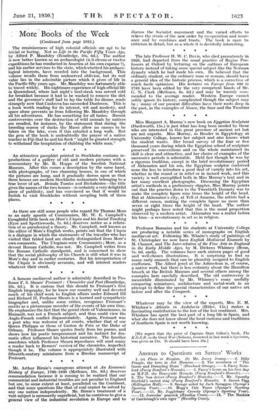Miss Margaret A. Murray's new book on Egyptian Sculpture . (Duckworth,
15s.) is just what has long been needed by those who are interested in this great province of ancient art but are not experts. Miss Murray, as Reader in Egyptology at University College, knows her subject and also knows what the student wants. Her broad survey of the four or five thousand years during which the Egyptian school of sculpture preserved its conventions and on the whole maintained its skill is clear and attractive, and her choice of examples of the successive periods is admirable. Held fast though he was by a rigorous tradition, except in the brief revolutionary period of Akhenaten and his son, the Egyptian sculptor contrived none the less to introduce a good deal of variety into his art, whether in the round or in relief or in incised work, and this variety is well exemplified both in Miss Murray's text and in her many excellent photographs. Discussing the Egyptian artist's methods in a preliminary chapter, Miss Murray points out that the practice down to the Twentieth Dynasty was to make the complete figure nine times the height of the head. But at Akhenaten's city, at Tell el Amarna, the artists had a different canon, making the complete figure no more than seven or eight times the height of the head. The author might perhaps have noted that this is the usual proportion Observed by a modern artist. Akhenaten was a realist before his time—a revolutionary in art as in religion.








































 Previous page
Previous page